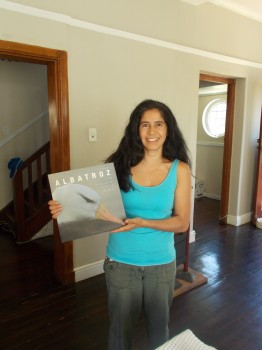Neves, T. 2013. Albatroz um Projeto pela Vida. São Paulo: DBA Dórea Books and Art. 132 pp. Hard cover with dust jacket and in full colour. ISBN 978-857234475-3. www.dbaeditora.com.br
Tatiana Neves, General Co-ordinator (Coordenação Geral) of Projeto Albatroz (the Albatross Project) in Brazil has written a captivating coffee-table book in Portuguese (English translation: ‘Albatross a Project for Life’) packed with striking double-page images showing off these magnificent birds, both albatrosses and petrels, on land and at sea, coupled with images of the people with whom they share the oceans and fate. Although the imagery is biased towards the Black-browed Albatross Thalassarche melanophris, the most commonly encountered albatross species off the Brazilian coast, other species are also beautifully depicted.

Albatroz um Projeto pela Vida by Tatiana Neves
The book is divided into four main chapters. Although each chapter is presented in the same way their subsequent layouts vary significantly in style and length, with the second chapter making up close to half the book. The initial pages contain the dedication, prefaces and a table of contents. The Acknowledgements are to be found at the back of the book together with a list of all recognized albatross species, highlighting those that occur in Brazilian waters. The main petrel species occurring in Brazil are also listed highlighting the ones that interact with fishing operations. A list of photographic credits and publishing information end the book.
The title cleverly introduces both the main subject of the author, the trajectory of the civil society organization Projeto Albatroz and the author’s own passion and engagement in this life’s project. It is almost devoid of technical language making for very accessible reading. The first chapter translates as the ‘Route of the Albatross’ and takes the reader along a time line of vignettes summarizing key turning points in the history of the organization from the early days and events that inspired its creation in 1990 to 2012 when it became part of Rede Biomar, a network of marine conservation organizations sponsored by Petrobras, the Brazilian state petrochemical giant.
The second chapter is not only the longest but also of most relevance to the Albatross and Petrel Agreement. The first half sets the scene with descriptions of the general biology of albatrosses, their behavioural traits, such as the migratory routes that bring the birds to the Brazilian coast and their adaptations to a life at sea and on land. All 22 albatross species are briefly mentioned along with the location of their main colonies. Next the author deals with the main problems facing albatrosses and petrels in general, but particularly in Brazilian waters. The main focus is on longline fishing and on a description of how this and other fishing practices common to Brazil pose a threat to the birds. Poignant photography of a Black-browed Albatross attempting to dislodge bait from a longline hook brings the message home. The chapter then flows seamlessly into a brief account of the inception of the organization before moving onto the main work done by Projeto Albatroz. This centres on how the work of adapting bird-scaring lines to Brazilian needs was achieved by working closely with fishers, and how this collaboration is at the core of the organization’s success. The chapter ends with a brief mention of milestones and of its recognition at national and more recently at international level. The chapter, although long, is to the point and kept alive through vivid and relevant photography engaging the reader through a thematic which could otherwise be technical and boring.
The last two chapters move away from a direct focus on the birds and deal with the education and outreach arm of Projeto Albatroz. They include various boxes with testimonies from fishers, on-board observers, members of the public and authorities. The book ends by briefly summarizing the work of the other four marine conservation organizations that form part of Rede Biomar.
I found the inconsistent presentation and layout styles between the chapters to be one of the few jarring notes. The slightly unconventional arrangement of preface texts scattered between other technical pages at the front of the book was a bit of a distraction, but the pleasing images quickly overcame that. The decision to first detail the Projeto Albatroz timeline (perhaps the most technical aspect of the book) in Chapter 1 before introducing readers to albatrosses and their plight in Chapter 2 is surprising, and although I found it engaging I suspect readers less familiar with albatross conservation may benefit from a different sequence.
In summary the book uses stunning imagery to full effect to draw readers in. This combines with readable and engaging prose to fulfil the objectives of inspiring and educating the layperson about the life and plight of these amazing birds. Furthermore, by tracking the progress and history of the organization Projeto Albatroz it informs us about the enormous efforts and on-going work that goes into their protection.
The book stands as a testament and example of what can be achieved through the tenacity, passion and humility of someone such as Tatiana Neves who has attended many ACAP meetings as part of the Brazilian Delegation and is currently serving as Vice-convenor of ACAP’s Seabird Bycatch Working Group. At every turn she writes of the collective effort that has gone into achieving each of the milestones. Although it is written mainly about the Brazilian situation and as such is in Portuguese, the lessons and messages are universal to other nations facing similar conservation issues, and it would be of great value to see it translated into the three official ACAP languages of English, French and Spanish.

Andrea Angel holds Tatiana Neves' book
Photographs by John Cooper
Andrea Angel, Cape Town, South Africa, 05 February 2014

 English
English  Français
Français  Español
Español